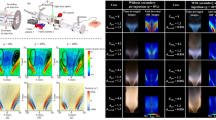Abstract
The influences of air preheating temperature, oxygen concentration, and fuel inlet temperature on flame properties, and NOx formation and emission in the furnace were studied with numerical simulation. The turbulence behavior was modeled using the standard k-ε model with wall function, and radiation was handled using discrete ordinate radiation model. The PDF (probability density function)/mixture fraction combustion model was used to simulate the propane combustion. Additionally, computations of NOx formation rates and NOx concentration were carried out using a post-processor on the basis of previously calculated velocities, turbulence, temperature, and chemical composition fields. The results showed that high temperature air combustion (HiTAC) is spread over a much larger volume than traditional combustion, flame volume increases with a reduction of oxygen concentration, and this trend is clearer if oxygen concentration in the preheated air is below 10%. The temperature profile becomes more uniform when oxygen concentration in preheated air decreases, especially at low oxygen levels. Increase in fuel inlet temperature lessens the mixing of the fuel and air in primary combustion zone, creates more uniform distribution of reactants inside the flame, decreases the maximum temperature in furnace, and reduces NOx emission greatly.
Similar content being viewed by others
References
Hasegawa T, Tanaka R, Niioka T, Combustion With High Temperature Low Oxygen Air in Regenerative Burners [A]. Hasegawa T, eds. Proceedings of the First Asia-Pacific Conference on Combustion [C]. Osaka: Osaka University Press. 1997. 290–3.
Yasuda T, Ueno C. Dissemination Project of Industrial Furnace Revamped With HTAC [A]. Blasiak W, eds. Proceedings of the Second International Seminar on High Temperature Combustion in Industrial Furnace [C]. Stockholm: Royal Institute of Technology Press, 2000. 275.
Dong W, Blasiak W. Large Eddy Simulation of a Single Jet Flow in Highly Preheated and Diluted Air Combustion [J]. Archivum Combustionis, 2000, 20(3–4): 163.
Dong W. Design of Advanced Industrial Furnaces Using Numerical Modeling Method [D]. Stockholm: Royal Institute of Technology, 1999.
Yuan J, Naruse I. Effects of Air Dilution on Highly Preheated Air Combustion in a Regenerative Furnace [J]. Energy and Fuels, 1999, 13(1): 99.
Hsiao T, Yang W, Jiang S J, et al. Experimental Investigation and Numerical Simulation of HiTAC Flames and Flow Phenomenon at Its Switching Moment [A]. Blasiak W, eds. Proceedings of the Second International Seminar on High Temperature Combustion in Industrial Furnace [A]. Stockholm: Royal Institute of Technology Press, 2000. 154.
Glassman I. Combustion [M]. San Diego: Academic Press Inc, 1996.
Author information
Authors and Affiliations
Corresponding author
Additional information
Foundation Item: Item Sponsored by National Natural Science Foundation of China (90210028)
Rights and permissions
About this article
Cite this article
Wang, Ah., Cai, Jj. & Xie, Gw. Numerical simulation of combustion characteristics in high temperature air combustion furnace. J. Iron Steel Res. Int. 16, 6–10 (2009). https://doi.org/10.1016/S1006-706X(09)60019-4
Revised:
Published:
Issue Date:
DOI: https://doi.org/10.1016/S1006-706X(09)60019-4




